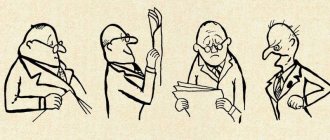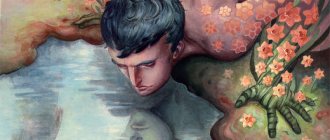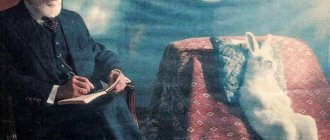Hello, dear readers of the KtoNaNovenkogo.ru blog. “This is character!” - we are talking about a person who is tough in his judgments, purposeful in life and unbending under the blows of fate.
As a rule, this remark is pronounced with a degree of envy and admiration. While “spineless” people do not evoke respect from others.
How does the first type of people differ from the second? And is it true that a person can lack character?
What is human character
Translated from Greek, character is translated as “seal”, “minting”, that is, on the one hand, it is a distinctive sign, and on the other, something stable and inherent in a specific subject or object.
In psychology, character
is a set of persistent individual personality characteristics that determines the type of behavior and the form of relationships with other people.
Character traits, as personality traits, are as follows:
:
- its components have a long-term effect, stability, and do not change quickly and easily;
- character has practical significance; it determines a person’s actions in all spheres of life.
A person can show heroism, cowardice, be anxious, aggressive or soft, weak-willed. If such manifestations occur frequently and are clearly expressed externally, then they will say about the person: “He has such a character.”
When a kind-hearted and gentle person flares up under certain conditions and shows aggression, then those around him will not call it character; rather, they will attribute it to specific circumstances.
Knowledge of a person’s character allows one to predict his behavior and actions in various situations, as well as correct them if necessary. We always know in advance who we can turn to for help, with whom we are not afraid to enter into risky ventures: “He can’t do anything differently, that’s his character.”
Kretschmer classification
Scientists, psychologists and other scientists have long distributed criteria for different personalities. It’s very simple, if a person doubts who he is, he can study the typology according to Kretschmer.
This outstanding person created a table for determining a person’s character by his physique. Here we can distinguish 3 main typologies:
- Picnics. People are short, overweight, have short necks and small heads. They belong to the cyclothymic character type. Sociable, good-natured, but very emotional personalities.
They get along well in society, are not prone to serious scandals, and can get along with even the most unpredictable creatures. Such figures are prone to certain mental illnesses, such as manic-depressive psychosis.
- Asthenics. Men and women of tall, thin build. Long arms and legs immediately reveal such personalities. The face is elongated and thin, with many facial wrinkles. The character type of such individuals is schizothymic.
Figures of this type rarely smile, are not prone to constant fun, and take life very seriously. Stubbornness and isolation allow them to achieve success in their careers and personal lives. They may suffer, like picnics, from mental illness. Most often, patients classified as asthenics develop schizophrenia.
- Athletics. The name speaks for itself. Personalities of this type are tall, broad-shouldered, with prominent muscles. The category of such people is ixothymic. Athletics are stubborn, reserved and resilient people.
They clearly follow the goal and achieve it by any means. A calm, balanced life helps them deal with hardships, but they are very afraid of change, as they do not adapt well to the new environment and the surrounding society.
Many years of research by scientists have proven that people of the same race have similar character traits. The famous scientist Anders Retzius studied the Nordic character for a long time.
It was he who introduced the term “Nordic” for a more clear separation of all types and categories. He took the Germanic races as a basis for his research, and made a real breakthrough in his endeavors.
During the work, it became clear that individuals of German origin are tall, not overweight, have blond hair, and blue eyes. They are distinguished by endurance, resistance to external irritants, very cool-blooded and calm even in emergency situations.
Character Traits: General Information
Not every feature of a person can be attributed to his stable, permanent character trait. We have already said that a good-natured person can lose his temper, and, for example, an optimist can fall into melancholy. But we will not describe the first as an aggressor, and the second as a whiner.
In psychology, there are three leading groups of character traits, which together constitute it.
1 group of traits - attitude towards oneself
This group includes both positive and negative characteristics that show the individual’s attitude towards himself and his self-awareness.
Character traits with a plus sign
- inner dignity, honor, pride, self-criticism, appropriate modesty, adequate self-esteem.
Traits with a minus sign
- vanity, inflated self-esteem and self-esteem, pride (not to be confused with pride), touchiness, shyness (not to be confused with modesty).
Group 2 – attitude towards others
Characteristics that show the basis of a person’s relationships with other people - in the family, in a team, in a circle of friends.
Character traits with a plus sign
- responsiveness, respect, communication, sensitivity, willingness to help, ability to work in a team, decency.
Traits with a minus sign
- callousness, contempt for others, snobbery, rudeness, neglect, isolation, callousness, individualism.
3rd group of traits – attitude to activity
This group combines character traits related to their business, profession, and work in general.
Character traits with a plus sign
- hard work, activity, responsibility, creativity, a penchant for creativity, initiative.
Traits with a minus sign
- laziness, procrastination, irresponsible attitude to business, lack of initiative, passivity.
Based on a sample of these characteristics, you can create a portrait of a person.
Video
Coffee capsule Nescafe Dolce Gusto Chocochino, 3 packs of 16 capsules
1305 ₽ More details
Hot chocolate capsules Nescafe Dolce Gusto Chococino, 8 servings
334 ₽ More details
Gardena hose trolleys
Features of human character formation
For a long time, philosophers believed that character is an innate human trait. That is, he is born with a certain set of qualities that do not change during the formation process. Today this view is not supported. It has been proven that character is formed throughout life and depends on upbringing, environment, entry into a certain social group, professional activity, etc.
For the first time, the idea of a significant influence on the character of external factors was expressed by the scientist D. Locke, who argued that psychophysical properties and upbringing influence the formation of character equally.
Modern science (last century) supports this hypothesis.
According to researchers, personality formation is influenced by
:
- labor education;
- personal example;
- physical education;
- self-development;
- moral and ethical education;
- correct formation of habits.
Regardless of age, the process of character formation is exposed to the influence of the information field, including the perception of the individual
:
- cultural values, ideology cultivated in society;
- personal example of people respected for a particular person;
- public opinion and common judgments in society;
- literature, television, cinema, theater.
A mature, thinking person can also correct his character. Thus, character formation occurs throughout life.
Three main factors influence its changes
:
- physiological (gender, temperament);
- social (education, culture, family, school, team);
- personal (self-development, self-education).
The first stage of character development is early infancy. At this level, it is very important to give the child love, care, and a lot of attention, since it is here that the emotional component is formed for the rest of his life.
Further personality development occurs in early preschool age. The child studies and copies the behavior patterns of adults nearby. Direct teaching with appropriate emotional reinforcement (praise) is important. It is at this age that such traits as kindness, responsiveness, and hard work are formed.
At primary school age, the main role is played by the assessment of the child’s actions and actions by adults, the concepts of “good” and “bad” are instilled. Character traits related to work appear: responsibility, punctuality.
Adolescents are actively developing moral and ethical standards and their volitional sphere. By the end of school, the character, as a rule, has already been formed; then it is only corrected.
The relationship between temperament and character
Character and temperament are often identified, but they are different concepts.
In psychology, different points of view have been expressed on this matter.
:
- both concepts are identical;
- temperament is a part, the core of character;
- two concepts are antagonists;
- temperament is the natural basis of character.
Temperament is more closely related to the properties of the human nervous system and is directly determined by them. Character is greatly influenced by society and upbringing. If character is subject to correction, then temperament is an innate property that remains with the individual for life.
The social environment in which an individual grew up and lives has a strong influence on character, while temperament remains unchanged. The content of a person’s actions depends on character, but only their manner and style depend on temperament.
Important: temperament cannot be assessed as “good” or “bad”, but character consists of those traits that can be regarded as positive or negative.
The type of temperament and character are connected and interact with each other in a single appearance of a person, forming an inseparable alloy - a characteristic of his individuality.
Typology according to Jung
For centuries, humanity has been studying each other, each scientist tries to present his point of view and spread it to the masses. A psychiatrist from Switzerland did not stand aside and began to study humanity based on its internal and external awareness of the world. It turned out to distinguish 2 main types:
- Introverts. These are calm, reserved individuals who do not like noisy companies and many friends. As a rule, they live separately, separately from the bulk of the population, and have very difficult contacts with society.
They prefer stability and loneliness, rarely change their place of work or residence. They think and reflect a lot, which leads to anxiety and suspiciousness. Subjects of this category are easily manipulated by others and are often inspired by religious ideas.
- Extroverts. These are cheerful, sociable and emotionally unstable people. Always in the center of attention, they love companies and everything related to parties.
They live to the fullest, forgetting about minor problems, and even the troubles of other people close to them. A complex but peaceful character allows one to find a common language with society, regardless of social status.
When analyzing all types of topology, you should not immediately equate yourself to one or another type; there are psychologists and other specialists for this. Emotional, suggestible people can begin to delve into themselves, while losing common sense. This can change your whole life. Be careful with self-criticism.
What are the character types?
In psychology, there are several classifications of character types. One of the most famous is the typology proposed by the American psychoanalyst Alexander Lowen.
| Character type | Its characteristics |
| Oral | A person experiences a sharp change in mood and is highly dependent on others. Infantility, tendency to melancholy and depression, fear of rejection, low self-esteem. |
| Masochistic | A person who loves to suffer has a very high sensitivity. There is intuition. They are not confident in themselves, they are closed. |
| Hysterical | High level of ambition, ability to control behavior and actions. Arrogance, rational thinking. Developed emotions with the ability to contain them. |
| Schizoid | Very low self-esteem, lack of control over emotions and their inadequacy. Affective disorders. |
| Psychopathic | Desire to dominate, increased anxiety. The predominance of image issues over internal content. Preoccupation with control over circumstances. |
| Narcissistic | Self-confidence, high ambitions. Aggressiveness, assertiveness, arrogance, tenacity. |
Also in psychology, individuals are divided into introverts (closed) and extroverts (sociable).
One more typology of characters can be identified
.
| Character type | Its characteristics |
| Hyperthymic | The person is very sociable, “talkative”, with pronounced facial expressions. Lots of initiative and energy, but loses his temper easily. |
| Disthymic | Pessimists are introverts. They have a keen sense of justice and a very limited circle of friends. They make decisions hard and are slow. |
| Excitable | They are power-hungry and love conflict situations. Very unpleasant to communicate with. When calm, they are attentive and pedantic; when excited, they are aggressive and irritable. |
| Stuck | An arrogant person, loves to teach others, considers himself smart. Excessive demands on both yourself and other people |
| Anxious | The personality is extremely insecure, afraid of disputes and conflicts. Looks for support everywhere. |
| Demonstrative | Sociable, adaptable. Schemer. They can cause irritation due to their self-confidence. Born artists, boastful, hypocritical. |
A few more words about cheerfulness
Let's look at the definition in more detail. Cheerfulness is:
- the ability to see the positive in everyday things that few people bring joy, for example, in the early morning, in a mug of tea, in rain and snow;
- the ability to not lose heart in difficult situations;
- a friendly perception of life, whatever it may seem at the moment;
- the ability to trust the future without worrying about it;
- the ability to understand that life is the most valuable gift a person has;
- the ability to be happy here and now, without attachment to the past and unnecessary anxiety.
Psychological character of a person
Character is one of the components of the psychological portrait of a person. But it alone is not enough to form a full-fledged opinion about a person, which is necessary, for example, for hiring a responsible job or making an informed choice in your personal life.
At the same time, you need to determine the person’s temperament.
There are four in total
:
- sanguine
_ A person with a stable nervous system is quite mobile and balanced. The processes of excitation and inhibition of the nervous system quickly appear and also quickly decline. Optimistic, sociable. The downside is that they are capable of irresponsibility and frivolity. - choleric
_ A very mobile nervous system. It gets excited quickly, but cools down slowly. Extremely restless, always having to do something, energetic. Disadvantages: conflict-ridden, aggressive, hot-tempered. - phlegmatic
. The nervous system is very stable and balanced, but not dynamic. Cannot switch from one topic to another, does not work at “high speeds”. But the result will be impressive - everything is thought out to the smallest detail. Reliable, responsible. Disadvantages - clumsy, rather dry in communication. - melancholic
. The nervous system is very weak, vulnerable, impressionable. Soft, sensitive people. Cons: low performance, suspiciousness, isolation.
Individual abilities are considered as the third component within the psychological portrait
:
- general, formed under the influence of intelligence. This is mental flexibility, hard work, and the ability to adapt.
- special, appealing to a certain direction: to oneself personally, to communication, to completing a task.
To compile a psychological portrait, the following are also taken into account: intelligence, emotionality, feelings, communication skills, stress resistance, self-esteem.
Social character of personality
The concept of social character was introduced into science by E. Fromm.
Social character of personality
is a set of traits that arises in people belonging to the same social group. Moreover, these special features appeared under the influence of common experiences and an identical lifestyle.
The psychologist has developed two types of social characters: unfruitful and fruitful.
Unfruitful
| Type of social character | Its signs |
| Receptive | Characterized by weakness of will, servility, low activity, cowardice. |
| Operational | Ambition, a high level of aggression, egocentrism, and arrogance are inherent. |
| Cumulative | Dominant signs: lack of creativity, causticity, stubbornness, possessive instinct, suspiciousness, |
| Market | Characterized by such features as: lack of integrity, unprincipledness, low sense of purpose |
These types are called unfruitful because they are “takers”, believing that they can only receive benefits from the outside.
Fruitful type
This is a kind of humanistic ideal to which we need to strive. It is characterized by: reliance on one’s own strengths and their use both to receive benefits and to give to other people. A fruitful social character gives and does not receive; it is based on love, the highest degree of which is maternal love, which does not know selfishness.
Hidden and obvious accentuation of personality
Accentuation refers to the dominant personality traits, that is, some characteristics are moderately developed in us, while others are excessively developed.
As a result of accentuation (from the word “accent”, i.e. strengthening), the personality becomes disharmonious.
Strengthening individual traits
:
- cause a person’s vulnerability, are his weak point, “Achilles’ heel”;
- limits a person’s abilities in certain areas of activity.
For example, a personality with an accentuation of weak will can be used by people and is completely unsuitable for working in leadership positions.
Accentuation is not a psychological or mental deviation, but an extreme variant of the norm.
There are several reasons for this
:
- dominance of one trait is formed only at certain stages of development, and can be minimized with age;
- accentuation does not always appear, but only under certain circumstances;
- accentuation does not in any way prevent a person from adapting to society, with the exception of a number of restrictions that we mentioned above.
Depending on the dominance of one of the character traits, the following types are distinguished:
:
| Type of accentuation | Characteristic |
| Demonstrative | The desire to be in . Deliberate behavior, boasting. |
| Pedantic | Caution, fear of change, thoroughness, thoughtfulness. |
| Excitable | Very impulsive behavior. Lives by impulses, instincts, drives. |
| Hypertemic | Always cheerful, active, thirsty for life. Sociable, optimistic, easily overcomes difficulties. |
| Stuck | Remembers insults and troubles for a long time, is vengeful, petty |
| Dysthymic | Pessimist, always sad and despondent. Concentrated on the dark sides of life. |
| Cyclothymic | Changes from thirst for life to pessimism occur frequently and regularly. |
| Exalted | A violent reaction to any event, a state from delight to universal sadness. |
| Emotive | High sensitivity, empathy, sincerity, tearfulness. |
| Anxious | Anxiety for any reason and for no reason. Wariness, timidity, uncertainty. |
Accentuation is considered obvious in cases where it accompanies a person most of the time, almost always.
If the dominance of any trait appears in stressful or critical situations, then the accentuation is called hidden.











